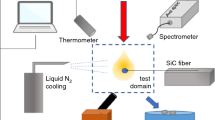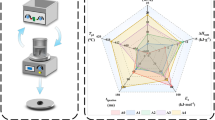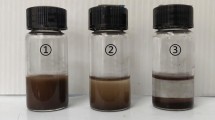Abstract
A CO2 laser ignition system was used to ignite the pure JP-10 (endo-Tetrahydrodicyclopentadiene, C10H16) and aluminum (Al)/JP-10 nanofluid droplet. Online combustion diagnosis and combustion residue analysis were combined to study the effect of solid content and atmosphere on the ignition and combustion characteristics of the Al/JP-10 nanofluid droplet. The combustion process of JP-10 can be divided into three stages, namely, ignition, steady burning, and extinguishment, while the combustion process of Al/JP-10 nanofluid can be divided into four stages, namely, ignition, mixed burning, mass burning, and extinguishment. Aluminum nanoparticles can effectively improve the volume calorific value of fuel. With the increase in solid content, the ignition time of the droplet is significantly shortened and the combustion intensity is increased. However, the increase of solid content introduces particle agglomeration problems, which decreases the oxidation degree of Al nanoparticles. Compared with air, the intensity of droplet combustion increases significantly in oxygen atmosphere. The highest combustion temperature of the fuel droplet with a solid content of 10% reached 1843 °C, the oxidation efficiency of the residues increased significantly, and the combustion efficiency of aluminum particles reached 99.26%.














Similar content being viewed by others
References
Farrar RB. High-density fuel to extend range of ramjet missile. JSpRo. 1968;5(11):1364–7.
Segal C, Friedauer MJ, Udaykumar HS, Shyy W, Marchand AP. Ignition characteristics of a new high-energy density fuel in high-speed flows. J Propuls Power. 1997;13(2):246–9.
Wang L, Zhang X, Zou JJ, Han H, Li Y, Wang L. Acid-catalyzed isomerization of tetrahydrotricyclopentadiene: synthesis of high-energy-density liquid fuel. Energy Fuel. 2009;23(5):2383–8.
Wang W, Liu Y, Li N, Li G, Wang W, Wang A, et al. Synthesis of renewable high-density fuel with isophorone. Sci Rep. 2017;7(1):6111.
Chenoweth K, Duin ACTV, Dasgupta S, Iii WAG. Initiation mechanisms and kinetics of pyrolysis and combustion of JP-10 hydrocarbon jet fuel. J Phys Chem A. 2009;113(9):1740–6.
Choi SUS. nanofluids: from vision to reality through research. J Heat Transf. 2009;131(3):033106.
Kim DC, Kim JH, Woo JK, Shin DH, Lee YS, Kaushik RD. A new iron-nanofluid as fuel additive for particulate matter reduction in heavy fuel oil-fired boiler facility. Asian J Chem. 2008;20(7):5767–75.
Gan Y, Li Q. Combustion characteristics of fuel droplets with addition of nano and micron-sized aluminum particles. CoFl. 2011;158(2):354–68.
Tanvir S, Li Q, editors. Burning characteristics of liquid fuels with suspensions of energetic nanoparticles: the effect of droplet size. Aiaa/asme/sae/asee Joint Propulsion Conference; 2013.
Gan Y, Yi SL, Li Q. Combustion of nanofluid fuels with the addition of boron and iron particles at dilute and dense concentrations. CoFl. 2012;159(4):1732–40.
Meda L, Marra G, Galfetti L, Severini F, Luca LD. Nano-aluminum as energetic material for rocket propellants. Mater Sci Eng C. 2007;27(5–8):1393–6.
Yetter RA, Risha GA, Son SF. Metal particle combustion and nanotechnology. Proc Combust Inst. 2009;32(2):1819–38.
Ohkura Y, Rao PM, Zheng X. Flash ignition of Al nanoparticles: mechanism and applications. CoFl. 2011;158(12):2544–8.
E XTF, Pan L, Wang F, Wang L, Zhang X, Zou JJ. Al-nanoparticle-containing nanofluid fuel: synthesis, stability, properties, and propulsion performance. Ind Eng Chem Res. 2016;55(10):2738–45.
Tyagi H, Phelan PE, Prasher R, Peck R, Lee T, Pacheco JR, et al. Increased hot-plate ignition probability for nanoparticle-laden diesel fuel. Nano Lett. 2008;8(5):1410.
Takahashi F, Heilweil IJ, Dryer FL. Disruptive burning mechanism of free slurry droplets. Combust Sci Technol. 1989;65(1–3):151–65.
Javed I, Baek SW, Waheed K. Evaporation characteristics of heptane droplets with the addition of aluminum nanoparticles at elevated temperatures. CoFl. 2013;160(1):170–83.
Xie L, Kishi T, Kono M. Investigation on the effect of electric fields on soot formation and flame structure of diffusion flames. Symp Combust. 1992;24(1):1059–66.
Author information
Authors and Affiliations
Corresponding author
Rights and permissions
About this article
Cite this article
Chen, B.H., Liu, J.Z., Li, H.P. et al. Laser ignition and combustion characteristics of Al/JP-10 nanofluid droplet. J Therm Anal Calorim 135, 925–934 (2019). https://doi.org/10.1007/s10973-018-7393-6
Received:
Accepted:
Published:
Issue Date:
DOI: https://doi.org/10.1007/s10973-018-7393-6




